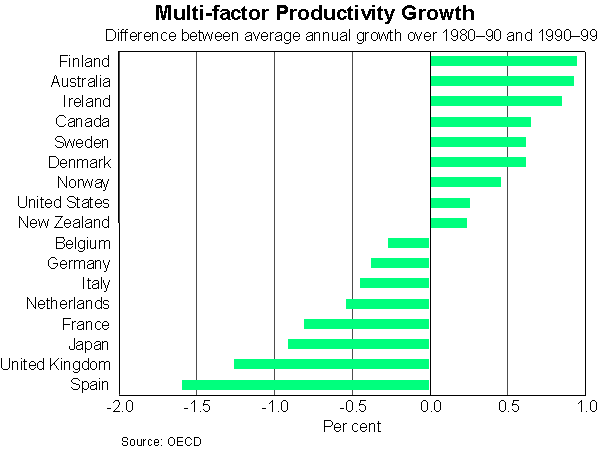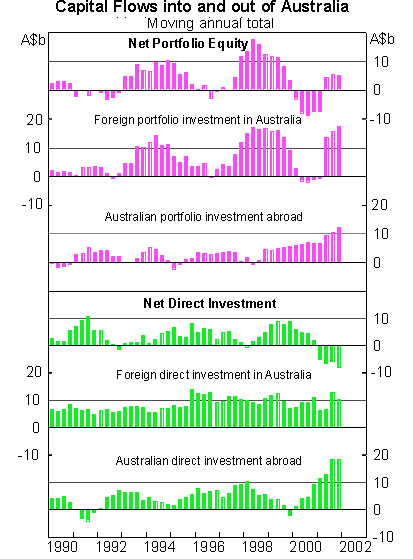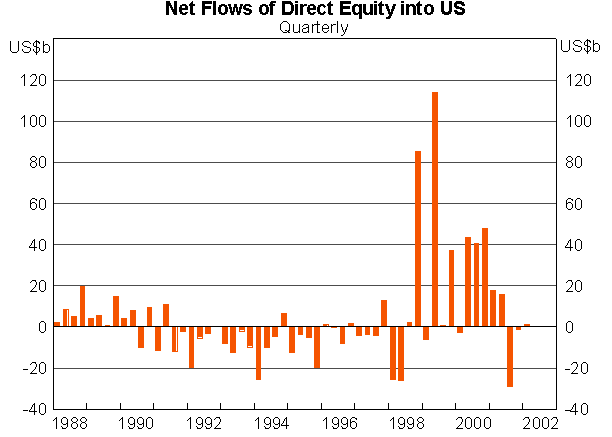Speech Relative Advance or Relative Decline?

I.J. Macfarlane
Governor
Talk to The Economist Group's 7th
Foreign Investor Roundtable with the Government of Australia
Canberra –
I would like to start by thanking The Economist Group for inviting me to be the guest speaker at the 7th Roundtable. These Roundtables have served a very useful purpose since their inception in the late 1960s, and I am sure this one will be just as productive. When I was invited to give this address, I was told that it would be part of a session entitled ‘Australia in 2020: strikingly similar, significantly different, or in relative decline’. From this, I assumed that I was required to speak on medium-term issues, which I am always very happy to do. But since I have a couple of difficulties with the session title above, I may not stick to the script expected of me.
My first difficulty is that I am wary of forecasts going out as far as 2020. These have a tendency to be not much more than projections of current short-term trends and can be quite misleading; this was the case with those produced by the Club of Rome in the seventies showing the world running out of commodities, and those made in the eighties showing the level of GDP in Japan exceeding that of the United States. My other difficulty is with the inclusion of the phrase ‘relative decline’ as a possibility, without specifically mentioning the possibility of ‘relative advance’. This may be nothing more than a ‘Freudian slip’, but nevertheless, I will use it as the theme for my talk tonight.
It is a theme I have touched on before – the tendency for Australians to be pessimistic about their economic future. The reasons for this pessimism have varied from decade to decade, and there have been a few new ones added in recent years, but the overall tone seems to be relatively constant, and relatively impervious to changes in our actual economic condition. I would have thought that, after a decade in which our growth performance has been the best in the OECD area (with a couple of minor exceptions),[1] most of the pessimism should have receded, but I doubt that it has. In order to assist in this process, I would like to recall some facts before moving on to discuss the arguments.
I have already mentioned our growth performance in the past decade. The actual numbers are shown in Table 1, which uses calendar year 1990 as the base and shows the average growth rate up to the most recent quarter (March quarter 2002). Note that by using 1990 as the base, we include the early nineties recession for all countries in the average, as well as the later expansion.
| 1990-Current* | |
|---|---|
| Australia | 3.4 |
| Norway | 3.0 |
| United States | 3.0 |
| Canada | 2.7 |
| Netherlands | 2.6 |
| New Zealand | 2.6 |
| Portugal | 2.6 |
| Spain | 2.6 |
| Austria | 2.4 |
| United Kingdom | 2.2 |
| Denmark | 2.1 |
| Belgium | 2.0 |
| Finland | 1.9 |
| France | 1.8 |
| Germany | 1.6 |
| Sweden | 1.6 |
| Italy | 1.5 |
| Japan | 1.1 |
| Switzerland | 0.9 |
| * Greece, Iceland, Ireland and Luxembourg not included due to data limitations. | |
Part of our stronger growth can be explained by faster population growth, but we also have put in an excellent productivity performance over the decade as well. In the work done by the Federal Reserve Board in the United States[2] and by the OECD in Paris,[3] Australia is identified as one of the group of countries that has increased its rate of productivity growth (whether measured by labour or multi-factor productivity) in the nineties compared with the eighties. Graph 1, which is reproduced from the OECD, shows Australia is second only to Finland in its acceleration in multi-factor productivity.

The trends I have mentioned are not confined to the 1990s, although that was clearly our best decade in terms of relative advance. If we look at the broader picture over the past 20 years, Australia is still in the very small group of advanced countries to have increased its share of world output. Using the IMF's annual database,[4] it is possible to discern some interesting longer-term trends from developments over the past 20 years. This is a useful exercise because it is an antidote to the type of thinking which concentrates on very recent developments, some of which I will cover later.
The two main trends that are of relevance for tonight's topic are as follows:
-
Our region – which is mainly the developing countries of Asia – has grown
a lot quicker than the world as a whole and so its share of world output has
risen from 10½ per cent in 1980 to 24 per cent
in 2001. Not only has the total risen, but each country, with the exception
of the Philippines, has been able to increase its share of world output (Table 2).
It is worth reminding ourselves of this major trend, because it tends to be
overshadowed by our more recent memory of the Asian crisis of 1997 and 1998.
Table 2: Asian Output
(per cent)Share of World Output Change in share 1980 2001 1980-2001 China 3.42 12.03 251.9 India 2.78 4.68 68.6 Korea 0.73 1.69 131.2 Indonesia 1.12 1.55 38.1 Taiwan 0.50 0.99 99.4 Thailand 0.54 0.93 73.2 Philippines 0.79 0.67 −15.6 Malaysia 0.24 0.44 86.0 Hong Kong 0.26 0.40 50.6 Vietnam 0.18 0.36 93.6 Singapore 0.11 0.24 111.6 Total 10.67 23.96 124.7 Total (excl. China) 7.25 11.93 64.6 -
In contrast, the developed countries of the OECD area have grown less rapidly than
the world average and their share of world output has fallen from 57.5 per cent
in 1980 to 52.4 per cent in 2001. Within the group of developed
countries, only three have managed to increase their share of world output
– the United States, Australia and Ireland. If we leave out Ireland
because of its small size and its exceptional circumstances, Australia and
the United States are the only two developed countries of reasonable size
and reasonable initial income per head to have increased their share of world
output. Some people would discount our achievement by pointing out that a
fair bit of our increase in share was due to higher population growth resulting
from higher levels of immigration. But that should be seen as a strength rather
than a weakness if we are interested in which areas are growing and which
are declining in relative importance. Also, it points to favourable developments
in the future, as high-immigration countries are less susceptible to the strains
imposed by an aging population.
Table 3: OECD Output
(per cent)Share of World Output Change in share 1980 2001 1980-2001 United States 21.27 21.31 0.2 Japan 8.05 7.28 −9.6 Germany 5.66 4.50 −20.5 France 3.91 3.21 −18.1 United Kingdom 3.60 3.13 −13.2 Italy 4.00 3.09 −22.8 Canada 2.14 1.98 −7.7 Spain 1.89 1.76 −7.2 Australia 1.06 1.13 6.4 Netherlands 1.03 0.90 −12.8 Belgium 0.77 0.60 −21.7 Sweden 0.63 0.49 −23.2 Austria 0.57 0.47 −18.3 Switzerland 0.64 0.46 −28.4 Greece 0.48 0.39 −19.3 Portugal 0.41 0.38 −8.4 Denmark 0.40 0.34 −16.1 Norway 0.31 0.29 −5.9 Finland 0.32 0.29 −10.4 Ireland 0.16 0.25 58.1 New Zealand 0.21 0.17 −17.9 Total 57.5 52.4 −8.9
I have presented enough statistics for the time being. The purpose of highlighting these 20-year trends was not to imply that they must continue – they may not. My purpose was to ask the question ‘given this has happened over the past 20 years, why would you start with the presumption for Australia of relative decline – why wouldn't you start from the expectation of relative advance?’ Another way of viewing these statistics is to observe that, while there may have been some influences running against us, they have obviously been outweighed by influences acting in our favour.
What are these influences that are generally cited as acting against our long-term interests? I will start with the familiar, then move on to some of the more recently-cited ones.
The time-honoured reason for pessimism was the belief that there would be an inevitable long-run decline in Australia's terms of trade, i.e. that our export prices would stagnate, while our import prices would rise inexorably. This was tied up with the general lament that we had too small a manufacturing base, and were too dependent on ‘commodities’ produced by the rural and resource sector. There certainly was a lot of substance to this argument until recently, so I do not wish to belittle it, or declare it dead prematurely. But events over the past two decades or so have cast a lot of doubt on its future applicability. For example:
- Australia's terms of trade bottomed in 1986 and have risen since. It has not been an even rise, but each subsequent trough has been at a higher level than its predecessor. The main reason for this is not that export prices have been particularly buoyant, but that import prices, predominantly manufactures, have been weaker.
- This should come as no surprise since the nature of the world's manufacturing sector has undergone an enormous transformation over the past two decades. In 1980, only 25 per cent of the world's manufactured exports came from developing countries: by 2000, 80 per cent did so.[5] There has been a role reversal, and this has been accompanied by a loss of pricing power by exporters of manufactures that has effectively shifted real income to importing countries. It is hard to see how this process could not continue, with China and India still having so much capacity for further expansion.
The more recent sources of pessimism are of a very different nature, and very hard to analyse in simple economic terms. Let me start with a frequently-heard complaint in financial markets, and work from there. The complaint is summarised by the phrase ‘we (meaning Australia) are just not on the radar screen’. By this is meant the tendency for investors around the world to concentrate their efforts in the big markets, such as the United States and Europe, and to ignore us because of our small size and lack of strategic importance. There is no doubt that this tendency can be important at times, but we should not assume that it is permanent. Recently, we suffered from its effects, but there is no reason why it should continue, and it has not continued. Graph 2 on recent international capital flows into and out of Australia tells an interesting story.

First, it is certainly true that inward portfolio investment into Australian equities dried up for a time in 2000 and early 2001. This was consistent with the "we are off the radar screen" explanation, which itself was part of the international investment community's infatuation with the "new economy" and its disdain for the rest, including us. But the important thing is that it seems to be a phase that has passed into history with the rest of the "tech bubble" – inward portfolio investment has resumed again in recent quarters. Incidentally, inward direct investment continued at a relatively steady pace over recent years, and was largely unaffected by the tendency described above.
In the past, it was inward direct investment that attracted unfavourable comment. Foreign investment and multinational corporations were viewed with suspicion and accused of buying our best companies (in some sense, the opposite of the "we are off the radar screen" argument). Now the interesting tendency is in the opposite direction – Australian direct investment abroad is greater than foreign direct investment in Australia. Also, Australian portfolio investment abroad has risen strongly. What does this mean? Does it support another often-heard view that there are no good investment opportunities in Australia, and firms and investors are forced to go abroad?
The first thing to note is that Australia is still an overall net importer of capital, i.e. more is invested in and lent to Australia from abroad than we lend to or invest in other countries (a necessary corollary of running a current account deficit). Since the Government has little or no role in these investment flows, it is the world and Australia's private sector players that have chosen this outcome.
Notwithstanding this consideration, some people are still troubled by the amount of portfolio investment abroad by Australian institutions and direct investment abroad by Australian companies, accusing them of turning their backs on Australia. I think the situation is a bit better than this. My guess is that the bulk of the portfolio investment abroad is just a sensible diversification of assets by Australian investors and institutions. In 1983, before exchange controls were abolished, Australian portfolios had zero international diversification, and in time we will reach a level that is appropriate to our circumstances. In the meantime, we will see outflows as we move from zero to the optimal level. In addition, we should not forget that other countries are also diversifying their portfolios, and in the process purchasing Australian equities and bonds.
On direct investment, we are going through the second phase of Australian companies buying overseas assets. In the first phase in the late eighties, it was done rather indiscriminately with a lot of investment outside the investor's normal area of expertise. The results were not very good. More recently, however, most of it has been done by successful Australian firms that have reached their limit of expansion in their own industry locally, but are good enough to compete in other markets in their area of expertise. Thus, we have seen them expanding directly into overseas markets in transport, packaging, building supplies, shopping malls, property services, etc., mainly activities that cannot be serviced via exports, but require direct investment. I think this trend is to be applauded, and is a sign of the success of Australian business rather than its inadequacy. Although we are nowhere near as far down this path as, say, the Netherlands or Switzerland, their success shows that it is not only the major countries that can create viable international companies.
So far, I have not mentioned the other catchphrase – the "branch economy" – the belief that the companies in the peripheral countries will be swallowed up by larger companies centred mainly in the United States (and, to a lesser extent, Europe), leaving only branch operations behind. This is a more difficult concept to pin down, although I do not wish to dismiss it as a concern. There certainly are powerful forces towards centralisation that operate within economies, and between economies. These centripetal forces are primarily the result of improved technology, particularly in communications, media and transport. They are best analysed within the framework of ‘winner-take-all markets’[6] rather than in the more conventional discussion on globalisation.
If this is our concern, i.e. our best companies are falling into foreign hands, the thing we should mainly worry about would be a big rise in inward direct investment, but we have not seen this – we have seen a reasonably steady trend over recent years. Again, if this is our concern, we should applaud the success of Australian companies operating abroad, as shown by the recent strength of outward direct investment – although there will inevitably be tensions about where these companies will be listed and headquartered.
It will take a long time before we can put these issues into perspective. We are still too heavily influenced by the events of recent years whereby everyone seemed to be comparing themselves unfavourably against the US economy, and finding that they were losing out in the investment community's esteem. That situation is changing and, when the dust settles, I suppose some of the more extreme views about the magnetic pull of investment to the United States will recede. As explained, we have already seen this happening in the Australian figures on foreign investment and it is also showing up elsewhere, including in the US figures on capital movements, where net capital movements have returned to outflows after a few years of heavy inflows.

This is the note on which I think I should finish. We cannot predict the future: all we can do as a country is to try and make sure that we have an economy that is resilient enough to handle the shocks that it will inevitably face. We have done so successfully twice in recent years when we faced the Asian crisis of 1997/98 and the world recession of 2001. This should give us some confidence that we can handle the next one – whatever it is – as successfully.
Endnotes
The exceptions are Ireland and Luxembourg. [1]
C. Gust and J. Marquez,‘Productivity Developments Abroad’, Federal Reserve Bulletin, 86(10), 2000, pp 665–681. [2]
OECD, ‘The New Economy Beyond the Hype’, The OECD Growth Project, Paris, 2001. [3]
IMF, World Economic Outlook, database, available at <http://www.imf.org/external/pubs/ft/weo/2002/01/data/index.htm> [4]
World Bank, Globalisation, Growth and Poverty: Building an Inclusive World Economy, The World Bank Group and Oxford University Press, New York, 2002. [5]
RH Frank and PJ Cook, The Winner-Take-All Society: Why the Few at the Top Get So Much More Than the Rest of Us, Free Press, New York, 1995. [6]